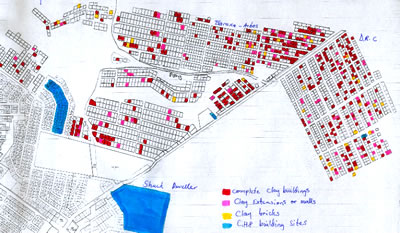Impact of clay construction in Orwetoveni
|
As the informal sector is not fully mapped, we had to draw a detailed map of some areas. We walked through the entire informal sector of Orwetoveni, counting every plot, with or without clay activity. We distinguished between complete clay buildings, clay extensions or walls and clay bricks.  The squatter settlements in Otjiwarongo have grown 500% in the last five years. At first, the shacks were built right next to the cemetery and close to main roads. As more and more people arrived, the area grew larger and now extends to the end of the which has been built during the last three years. Earlier research about the same theme was done by the CHP in 1995, when they counted around 270 plots and found only seven clay buildings. At that time people were not allowed to build with clay in temporary areas. Later on, permission was granted to build in those areas. In the area recently investigated, we counted 2077 plots. In total we found 310 complete clay buildings. They only differ in size; sometimes it is the main house on the plot and in other cases it is just a small toilet. There were even a few houses that were plastered and some were even painted. We also found 85 plots with clay extensions or walls and 34 plots that were storing clay bricks. This means that on 20.65% of the plots counted, people were actually building with clay. In the area most recently built up, it is even 22.74%. As we walked past six building sites in that area, we noted that on five they were building with clay and only one plot owner was building a metal shack.  The research revealed that the Clay House Project has a big impact on the local population. More and more people are choosing to live in clay houses instead of metal shacks. While it is clear to us that these clay buildings often look more like clay shacks, they are still an improvement. These clay shacks dont have foundations and the width of the walls does not exceed 20 centimetres. The advantage is that the people hire builders to build their houses because it is still cheaper than to buy metal sheets. This means that the money stays within the area and improves the local economy. |


